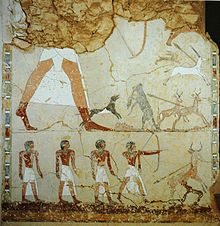Ineni

Ineni(sometimes transliterated asAnena) was anancient Egyptianarchitect and government official of the18th Dynasty,responsible for major construction projects under thepharaohsAmenhotep I,Thutmose I,Thutmose IIand the joint reigns ofHatshepsutandThutmose III.He had many titles, including Superintendent of the Granaries, Superintendent of the Royal Buildings, Superintendent of the Workmen in theKarnakTreasuries, etc.[1]
Ineni came from an aristocratic family and likely began his career as an architect under Amenhotep I. Amenhotep I commissioned Ineni to expand theTemple of Karnak.The expansion included abarqueshrine ofAmunand a new treasury. Ineni probably also oversaw the construction of Amenhotep I's tomb andmortuary temple.The mortuary temple was the first to be disconnected from the actual tomb, presumably so it would not draw attention to the burial site. Amenhotep I died before the treasury could be completed, but Ineni was retained by his successor, Thutmose I.
An avid builder, Thutmose I commissioned many construction projects during his rule, including the first tomb carved out at theValley of the Kings.Many of his projects were at the Temple of Karnak and were under the supervision of Ineni. These works included the fourth and fifthpylons,numerous courts and statues, the completion of the Treasury expansion begun by Amenhotep I, and ahypostylehall ofcedar woodconstructed at Karnak to commemorate Thutmose I's victory over theHyksos.
After the death of Thutmose I, Ineni was once again retained by the royal family. During the reign of Hatshepsut, a new architect,Senemut,would gain major commissions; most notably the construction of her mortuary temple atDeir el-Bahri.Ineni, however, continued to supervise several structures commissioned by Hatshepsut and was likely consulted on many others. He was considered by his contemporaries to be one of her court favorites, and thesteleson the walls of his tomb speak kindly of her. He died during the reign of Hatshepsut before Thutmose III assumed the throne in Hatshepsut's 22nd regnal year.His tombwas one of the few structures where Hatshepsut's name was not chiseled out or replaced, perhaps out of respect for him.
References[edit]
- ^Weigall, Arthur (1910).A Guide to the Antiquities of Upper Egypt.London: Mentheun & Co. pp. 133–137.ISBN1-4253-3806-2.
Further reading[edit]
- Biography of Ineni inAncient Records of Egyptby J. H. Breasted, Part Two, sections 43ff and 99ff
